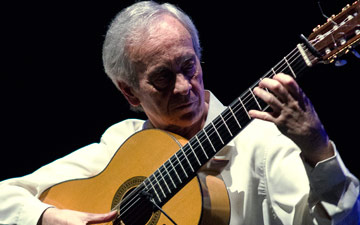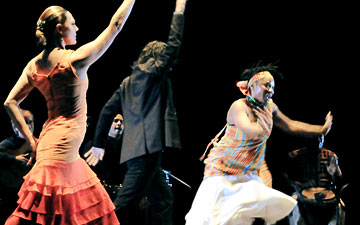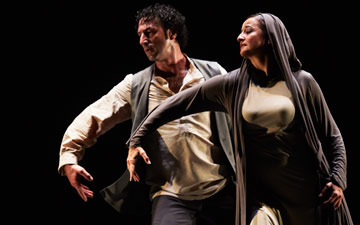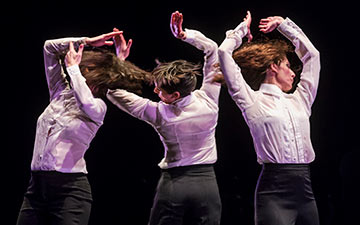
© Jeremy Toth. (Click image for larger version)
Paco Peña Flamenco Dance Company
Flamencura
London, Sadler’s Wells
23 June 2015
www.pacopena.com
www.sadlerswells.com
At 73, the legendary flamenco guitarist Paco Peña is not about to start taking it easy. Having made over 60 different flamenco shows, his recent creative trajectory has been to explore how traditional flamenco can be enriched by other musical cultures. In Peña’s latest production, Flamencura, he seeks to unravel and showcase the characteristics of traditional flamenco while also extending them into a soulful partnership with the Blues.
Peña defines Flamencura as being “the quality of flamenconess…the heart and soul of flamenco”; it is a term, he says, that embraces “…all the tools of the art”. It’s a word I’d not heard before – despite having clocked upwards of 40 flamenco reviews – but I like it, especially as so comprehensively defined by Paco and his pack, a close-knit ensemble that brings together the flamenco cream of Andalusia (all but one of his company appear to have been born in either Córdoba or Seville).
Odd-one-out is the British-born jazz vocalist, Vimala Rowe, who shows in a memorable duet with the flamenco singer, Jose Angel Carmona, that their distinct musical boundaries are not impermeable. Their respective song styles evolved as an escape from the drudgery of hard work in Southern Spain and the Southern States of the USA and – put together – their voices provide a transatlantic marriage of anguished soulfulness that shows how the characteristics of these musical forms are so closely related.
A non-narrative programme of ten “scenes” focussing on the various integral strengths of traditional flamenco needs a sense of theatre to hold it all together. And it gets just that from Peña’s ongoing collaboration with Jude Kelly. Although Peña comes from the heart of flamenco territory – born and raised in the Andalusian city of Córdoba – he now has a home in London (and a Dutch wife, Karin) and these intimate international influences shine throughout his work. Kelly also directed his hit show Quimeras, which developed a partnership of traditional Spanish and African music and dance, seen through the prism of migration. Kelly’s influence appears to have enveloped the constituent parts of Flamencura into a holistic theatrical work, where Tom Wickens’ lighting design – in particular – provides both flow and fluctuation in the work’s ongoing visual stimulation.

© Jeremy Toth. (Click image for larger version)
Flamencura begins with empty chairs scattered around the stage and the sound of music from some distant place. In due course, the core ensemble of nine musicians and dancers arrive and the female singer, Immaculada Rivero takes charge of the only stage embellishment, an elaborate, fringed shawl (el mantón) draped over the back of a chair. The company is progressively introduced through this opening Verdial, dominated by the pained expressions, gorgeous dresses (salmon pink and turquoise), undulating torsos and twisting hands of the two female dancers, Carmen Rivas (‘La Talegona’) and Charo Espino. The latter has been dancing with Peña for more than 20 years; the former joined for this production, in 2014.
The dancing was never short of extraordinary. The opening part showcased the cerebral seriousness of the Soleá – perhaps the most prolific of the flamenco forms (palos) – with a teasing dance of accelerating vitality by La Talegona against an orange background. She was introduced by the musicians’ encouraging cry of “Carmen, guapa” (beautiful) as she joined their rhythms with her castanets. The colour palette turned to blue for Espino’s sensual Tangos de Málaga, performed in a black-spotted dress, stamped with the intensity of her footwork and quickly changing body shapes (slipping in and out of forming the letter “S” in the undulating line of legs, hips, torso, arms, neck and head). The two women were joined by Espino’s husband – another long-time Peña dancer – Angel Muñoz, and his majestic, tempestuous, sometimes wild, sometimes restrained Soleá was the highlight of the latter stages of this show. In the breathe-easy lull after his flambouyant exit, a woman spectator shouted loudly into the silence “Come back”! It was probably what many others were thinking.
A brief narrative flavour emerged in the rarely-seen Petenera that closed the first act, a sombre dance from Cadiz that concerns the legend of a woman singer (cantadora) called La Petenera who lured men to their death through the dark art of seduction. Muñoz was La Talegona’s hapless victim in this danced interpretation of a work that carries a similar connotation of bad omens as Macbeth does on the English stage. In such circumstances, the sinister ending provoked some surprising laughter in the seats near to mine.

© Jeremy Toth. (Click image for larger version)
The extreme and expressive dance skills of this excellent trio were well matched through the anguished vocal range of Carmona, Rivera and the occasional, almost ethereal, presence of Rowe, the guitars of Rafael Montilla and another Paco (Arriaga) and the ever-present rhythms of the percussionist, Nacho López, supported by the hand clapping (palmas) of the collective. But, inevitably, the musical star of the show was its headliner. Peña holds his guitar high, the body resting on his thigh, the finger board projecting out at a precise 45° angle with the head stock rising well above the diminutive guitarist’s head; by contrast to the formality of this virtuoso’s style, the other guitarists held their instruments almost horizontally.
The evening had opened up early on to Peña’s assertive, fluid playing of the Rondeña with an unusual atmosphere of rapt attention and complete silence with noticeably no coughing or other noises from the audience. It was like floating lazily on a raft gently drifting in the breeze along a slow-moving river. Another guitar solo by the maestro came later in the programme, providing the aural backdrop to La Talegona’s controlled and beautiful solo, inspired by the palos of Granada.
The programme ended with a raucous series of Fandangos, set against a bright blue background, providing an opportunity for each member of the ensemble to showcase a solo, after which they drifted away as informally as they had arrived, leaving scope, of course, to return for some traditional role-reversal that saw the generous shapes of Rivero and López show their rhythm in dancing flamenco, while Carmona played guitar. It was a happy way to bring a wonderful evening of flamenco to an end; a programme that found an effective link into American jazz, gospel and the blues; achieving those connections with a strong mutual respect for the different cultures these two musical forms represent. The only disappointment was that we didn’t exit the theatre onto a warm evening in Córdoba. But, then you can’t expect everything from Sadler’s Wells!

















You must be logged in to post a comment.